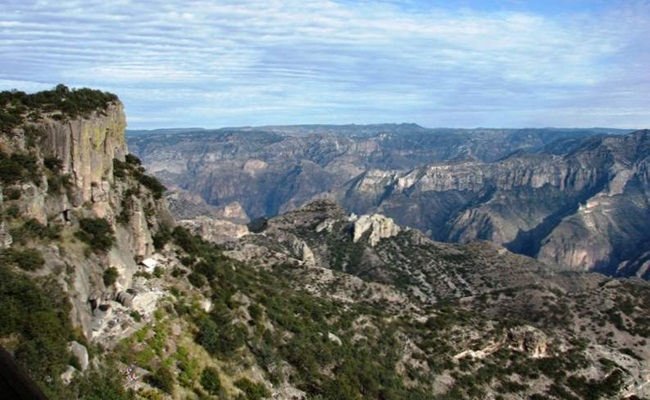But even beyond that, there is much to see in Mexico.
Copper Canyon
Mexico's Copper Canyon National Park is often compared to the Grand Canyon in the United States. And no wonder: the deep, dangerous gorges in the middle of the hot desert and connected by six picturesque rivers make a truly powerful impression on everyone who finds themselves here. But even beyond that, there is much to see in Mexico.
The canyon owes its name to the slopes overgrown with greenish moss. By mistake, the Spaniards mistook the moss for copper. By the way, in Russian, the name of this place is often translated as Cooper Canyon or Cooper Canyon (from the English word for "copper"). In an study tour, the guides are sure to mention it.
How to get there
The trip to Copper Canyon is a real journey. You can get here only on the comfortable El Chepe train from Mexico City, which is 655 kilometers long. During its journey, the train passes through 35 bridges and 80 tunnels. Along the way, you can see green mountains, rivers, waterfalls, and scenic bridges.
Weather in Copper Canyon
It is noteworthy that on the tops of the canyon and at its bottom there is always a difference in air temperature. This is due to the large differences in altitude, reaching 1.5 kilometers. In winter, for example, the slopes are always covered with snow, and at the bottom of it, subtropical forests grow. It is because of its climate that the area near the canyon is considered the most biologically active in Mexico. It is home to one-third of the country's mammals:
- the cougar
- the black bear
- the Mexican wolf
Copper Canyon is home to a huge number of birds and home to over three thousand plant species.
Where to stay
You can stay overnight in the town of Creel, located near all the main attractions of the canyon. You can find numerous hotels in Creel where you can book rooms in advance. The hotels offer tours under the guidance of professional guides.
Natural beauty of the Canyon
On the territory of the Copper Canyon National Park, there are a number of attractions created by nature itself. Among them are the highest waterfalls of Mexico, Piedra Voladai and Basaceachi, the dream of climbers and mountaineers, the steep rock of Pena del Gigante, the Valley of Monks, the Valley of Mushrooms, the Valley of Frogs, the thermal spring of Recovata, the settlement of the ancient Tarahumara Indians.
For tourists in Copper Canyon is prepared a lot of entertainment. Everyone can ride horses or mountain bikes, take part in rafting, climb the high mountain in climbing equipment, walk through the maze of trails.
By the way, the size of Copper Canyon is four times the size of the North American Grand Canyon. That's why climbers from around the world rush here to test their strength in extreme sports.
Soumaya Museum
A glance at the futuristic 46-meter high Sumaya Museum is enough to realize that it's going to be a sight to behold. It looks like a giant anvil or a skewed hourglass encased in shiny aluminum plates.

The museum's founder, Mexico's richest man, and gambling collector Carlos Slim named it after his deceased wife, Sumaya Dumit. The exhibition is based on the billionaire's private collection, including works by famous artists and sculptors, applied art, and artifacts from the pre-Columbian era. The total number of items in the funds is about 66 thousand.
The estimated value of the Sumaya Museum of Art exhibits exceeds $700 million.
What to see
There are no windows in the building; the light enters through a transparent roof. The interior space is divided into 6 levels, devoid of any partitions and stairs. You can get to the top in an elevator or by a giant spiral ramp connecting all the halls.
The first floor is dedicated to the history and culture of Mexico. There is also the world's largest collection of colonial-era coins. On the second floor are Oriental sculptures and wood and ivory carvings. Still higher are paintings by prominent European masters of the 15th to 20th centuries:
- Leonardo da Vinci,
- Tintoretto,
- El Greco,
- Bruegel,
- Renoir,
- Toulouse-Lautrec,
- Van Gogh,
- Degas,
- Picasso,
- Marc Chagall and other famous artists.
Mexican paintings are represented by the works of Rufino Tamayo and Diego Rivera.
The museum is especially proud of the world's second-largest collection of Rodin's works (380 sculptures), as well as Salvador Dali's sculptural masterpieces: "Profile of Time", "Space Elephant", "Jubilant Angel" and "Surrealist Piano" on dancing women's legs.
Practical information
Address: Mexico City, Boulervard Miguel de Cervantes Saavedra, 303. Web site.
The Touribus sightseeing bus Hop on-Hop off runs past the museum. The nearest metro stations are San Jordin and Polanco (both on line 7).
Opening hours: daily 10:30-18:30. Especially convenient to visit on Mondays, when other Mexico City museums are closed. Admission is free




























































































































































































